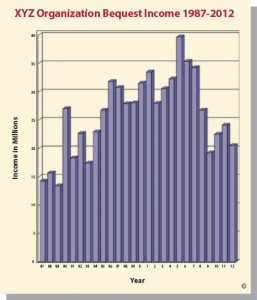Common wisdom is that a planned gift development effort can be expected to begin yielding measurable results in terms of increased income within three to five years. Numerous factors can affect that outcome, and if measurements such as new estate commitments are included, the return can be almost immediate. For purposes of this post, though, I’ll focus on results as measured by actual distributions received from estates.
Statistics compiled from many years of research of thousands of actual estate gifts, received by scores of organizations, indicate the following:
- The most common time period between the execution of a will that contains a charitable bequest and the donor’s death is one year.
- 25 percent of bequests nationwide come from those who pass away within one year of executing their final will.
- Over 50 percent of bequests come from those who pass away within four years of signing their final will, and over 80 percent within 10 years.
These statistics are also borne out by findings in recent studies by Dr. Russell James of Texas Tech University. (Click here for more details in the April 2014 issue of Give & Take).
Over more than 50 years of experience, Sharpe Group has rarely found an organization’s experience to deviate from these norms. If you don’t believe it, check your bequests received over the past few years and compare the date of the execution of the will with the date of the donor’s death.
What’s Happening to Organizations That Overrelied on Digital Marketing Too Soon
When social media started becoming popular in the late 2000s, many organizations jumped on board — focusing on Facebook likes, tweets and email blasts while dramatically decreasing planned gift marketing and stewardship efforts.
At the time, it seemed like a good move, right? Email marketing and social media were the constant topic of conversation in the press, and its costs were much lower than print and other traditional media.
However, the hard data is now showing the results of that decision. Here’s an example of an organization that abruptly switched its primary planned gift marketing from print to online e-marketing beginning in 2005.
As you can see, bequest income and numbers of realized bequests both dropped by significant amounts within three to five years after traditional marketing was curtailed. Similar results were experienced in the numbers of new gift annuity commitments. This followed a 20-year period of solid growth.
At this organization, bequest donors on average do not make their first gifts to the organization until their mid to late 70s. Unfortunately, this organization did not realize that the average age at the time donors fund gift annuities is 79, and that bequest donors are normally in the same age range when making their final will. (See Dr. James studies referenced above.)
When they switched to email-based marketing in 2005, less than 20 percent of people in that age range were online. Recent Pew Foundation reports reveal that 62 percent of people over age 77 are still not online and only 18% of people over 65 have smart phones. As a result, this organization inadvertently stopped communicating with as many as 80 percent of its prospective planned gift donors!
While this organization increased web traffic from younger people seeking free will planning kits and discovered a number of bequest intentions from younger people with life expectancies of 25 years or longer, this approach had little or no impact on donors over 75 — the majority of whom were not, and are still not, online.
The Damage Will Continue
Unfortunately, it will take another three to five years to arrest the decline and effect a meaningful reversal for this organization. By that time, this program will have experienced 10 years of interruption in growth and approximately $50 million in lost bequest revenue. All to save marketing expenses that would have totaled a miniscule fraction of this amount.
Is this an isolated case? Unfortunately not. Today, online marketing can indeed be a cost-effective way to plant seeds that will bear fruit in decades to come — and a marketing channel not to be ignored — but if you expect it to replace the marketing mediums that are proven to work with the most likely estate gift donors, while receiving the same results, you’re likely to incur a precipitous drop in your bequests and other planned gifts sooner than you might think.
Things may change in future years (as the Baby Boomers and Generation X who are comfortable using online media reach their 70s and 80s), but there’s no denying the hard data today.
The Solution
The organizations with the most successful programs know that it’s vital to keep messages designed to encourage bequests and other planned gifts in front of those donors who are statistically most likely to be making their final wills during a time frame that will result in a reasonable return on investment.
Connect with us if you’d like to understand the other truths that guide the most successful programs, and how to apply them to your program.
This post was excerpted from Mr. Sharpe’s opening presentation “Trends in Planned Giving” at the bi-annual national conference of the American Council on Gift Annuities on April 9, 2014.


